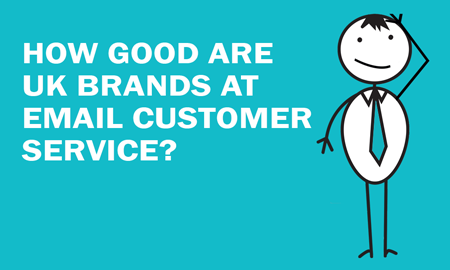How good are UK brands at email customer service?

Forrester recently reported that 69% of people still want to contact companies through email. However, UK brands are struggling to cope with the emails they receive, with performance overall worsening according to the latest Eptica Multichannel Customer Experience Study.
Email volumes are increasing year-on-year, and in some sectors (such as retail), email makes up30% of customer service interactions, with even mid-sized organisations receiving hundreds of emails every day. There are over 4.35 billion email accounts worldwide, a figure expected to increase by 26% by 2019. 122,500,453,020 emails are sent every hour, with a growing number coming from mobile devices. Additionally, as more basic queries are dealt with through the web, those raised on the email and voice channels are becoming more complex and time-consuming to answer.
All of these facts demonstrate that email is still a vital part of how every business interacts with consumers and delivers customer service. As part of the Eptica Multichannel Customer Experience Study, researchers attempted to contact 100 leading UK companies via email with a routine customer service question, and then evaluated them on the speed and accuracy of their response. This highlighted five key trends:
1. Email is being switched off
Many companies are simply giving up in the face of a growing deluge of emails. Just 64% of companies let non-customers contact them through email or text-based web forms on their sites. This was down from 74% in 2015, and was well below 2012’s total of 87%. Those that did offer email often made it difficult to locate, forcing customers to go through FAQ pages or hunt around to find details hidden in obscure corners of their websites. This ignores the potential revenues non-customers could bring and risks future profits by turning away new business. If email is the workhorse of customer service, too many companies are putting it out to pasture.
2. Email response rates are down
Even those companies that offer email, are less likely to provide an accurate answer. Just over half (52%) of companies responded to emails with 38% successfully replying to the query. The corresponding figures for 2015 were a 58% response, and 39% success, rate, showing drops in both metrics. This means that consumers contacting brands on Twitter, and Facebook, are more likely to receive an accurate response. Eight sectors worsened or stayed the same when it came to email accuracy.
3. Email is being deprioritised
Overall, many organisations gave the impression that they had given up on the battle to stay on top of email. The email address listed by one consumer electronics manufacturer on its website bounced, while the web form provided by a telecoms company brought up an error message when submitted. Only 34% of companies took the trouble to send an acknowledgement email with an expected timescale for a reply. 35% of these didn’t bother to give a time, just stating they would respond ‘ASAP’, ‘soon’ or ‘in due course’. Just 50% of these organisations then met their own deadlines – one that said ASAP took over 52 hours to reply.
4. Email is getting slower
In 2015 the average successful response time was 29 hours 27 minutes. In 2016 this had extended to 34 hours 15 minutes, although this masked considerable differences in speed. One consumer electronics retailer answered in 3 minutes, yet another company took 6 days and 8 minutes to respond. The utility sector was the most sluggish, taking over 64 hours on average. Overall, just 10% of companies responded to email within 2 hours, despite separate Eptica research finding that 58% of consumers would like to receive a reply within this timeframe.
5. Sector performance varies wildly
Amidst all the gloom, insurance stood out as a real success story on email. Not only did 90% of companies in the sector offer email, but all of them responded. Moreover all bar one successfully answered the question. This score of 80% (up from 50% in 2015) put the sector top for accuracy, ahead of electronics retailers (70%). In contrast, just 10% of banks and telecoms companies responded on email – and neither of the two consumer electronics manufacturers that provided an email address actually answered the question sent to them.
Email was just one of the channels evaluated by the Eptica Multichannel Customer Experience Study – do download our management report to see the full findings of the research.







Comments